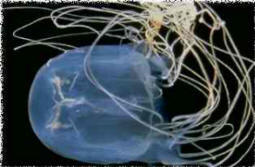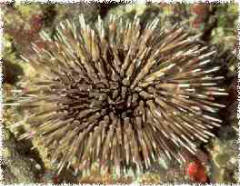Looking like feathery plants, and sometimes referred to as fireweed, hydroids are actually colonies of animals equipped with strong stinging cells (nematocysts) used to capture prey and for defence. Some species can give quite severe stings causing inflammation, swelling and pain lasting up to a week. Effects may sometimes be more severe.
Divers are particularly prone to brushing against hydroids. Two species to avoid are this white, fine feathery one and the denser yellow/brown type. They can be found in fairly shallow reef areas and on structures such as wharfs.
 Recognized as one of the greatest marine hazards, box jellyfish (Chironex fleckeri) kill more people than sharks, crocodiles and stonefish combined.
Recognized as one of the greatest marine hazards, box jellyfish (Chironex fleckeri) kill more people than sharks, crocodiles and stonefish combined.
Each year, in late summer, the adult box jellyfish spawn at river mouths before dying. The fertilised eggs become tiny polyps which attach themselves to rocks in estuaries. In spring these polyps develop into little swimming jellyfish which migrate down rivers, especially with rains, to feed on shrimp. Unfortunately, they frequent beaches which humans also find attractive. The animal does not actively hunt, relying on food to bump into its tentacles. A struggling shrimp might tear a delicate jellyfish, so it needs to be killed instantly, on contact, with a very strong poison.
Tentacles, up to 60 in number and reaching 5m in length, are arranged in four groups at the corners of a box-shaped bell which can be as large as a basketball. The tentacles are armed with up to 5 000 million stinging cells known as nematocysts. These are triggered into action when stimulated by certain chemicals found on the surface of fish, shellfish and humans. Contact with just 3m of tentacles can kill an adult.
Recent studies have shown that the box jellyfish is able to see through four eyes, one at the centre of each side of the bell. How it processes this information without a brain is still a mystery but the animal is able to avoid even quite small objects. They probably try to avoid humans in the water, if given the chance; stings usually occur when people blunder into them. (They are almost invisible in the water.) It is certainly in the interest of the jellyfish to avoid turtles which eat them, apparently unaffected by the stings.
Another box jellyfish, Chiropsalmus quadrigatus, is generally less common than Chironex fleckeri, although it may outnumber them on Cairns to Port Douglas beaches. It is smaller, with slimmer tentacles, but the two are difficult to tell apart. There are about 20 species, worldwide, in the Cubozoa, or box jellyfish, family, Chironex fleckeri is the most lethal member.
Although it is more numerous in summer months, the irukandji (Corukia barnesi) can be found all year round and inhabits all waters. A member of the box family, it has one tentacle at each corner of its bell. It is tiny - only 2cm across the bell - but nonetheless packs a massive punch. Both bell and tentacles have stinging cells.
The actual sting is minor, but 20-30 minutes later the victim begins to experience agony which lasts for hours. Although not blamed for deaths its tendency to cause raised blood pressure can be dangerous for vulnerable victims. Ignoring the initial sting may also lead to some people suffering severe symptoms in deep water or while driving.
 SEA URCHINS
SEA URCHINS
It is just common sense to avoid the sharp black spines of the black sea urchin. They can penetrate deeply into the flesh and break off causing long-lasting inflammation if not removed – often surgically. There is doubt as to whether venom is also involved.
A less common but much more dangerous urchin is the flower urchin. Instead of long spines it appears to be covered with numerous flowers which are in fact little venomous pincers (pedicillariae) capable of causing paralysis and even death. It has killed several people in Japan.
This octopus lives in shallow water, typically in sheltered rock pools and crevices, cans and bottles. Never put your hands where you cannot see them. The venom is not injected but enters the wound in saliva. Washing the bite may therefore remove venom from the surface.